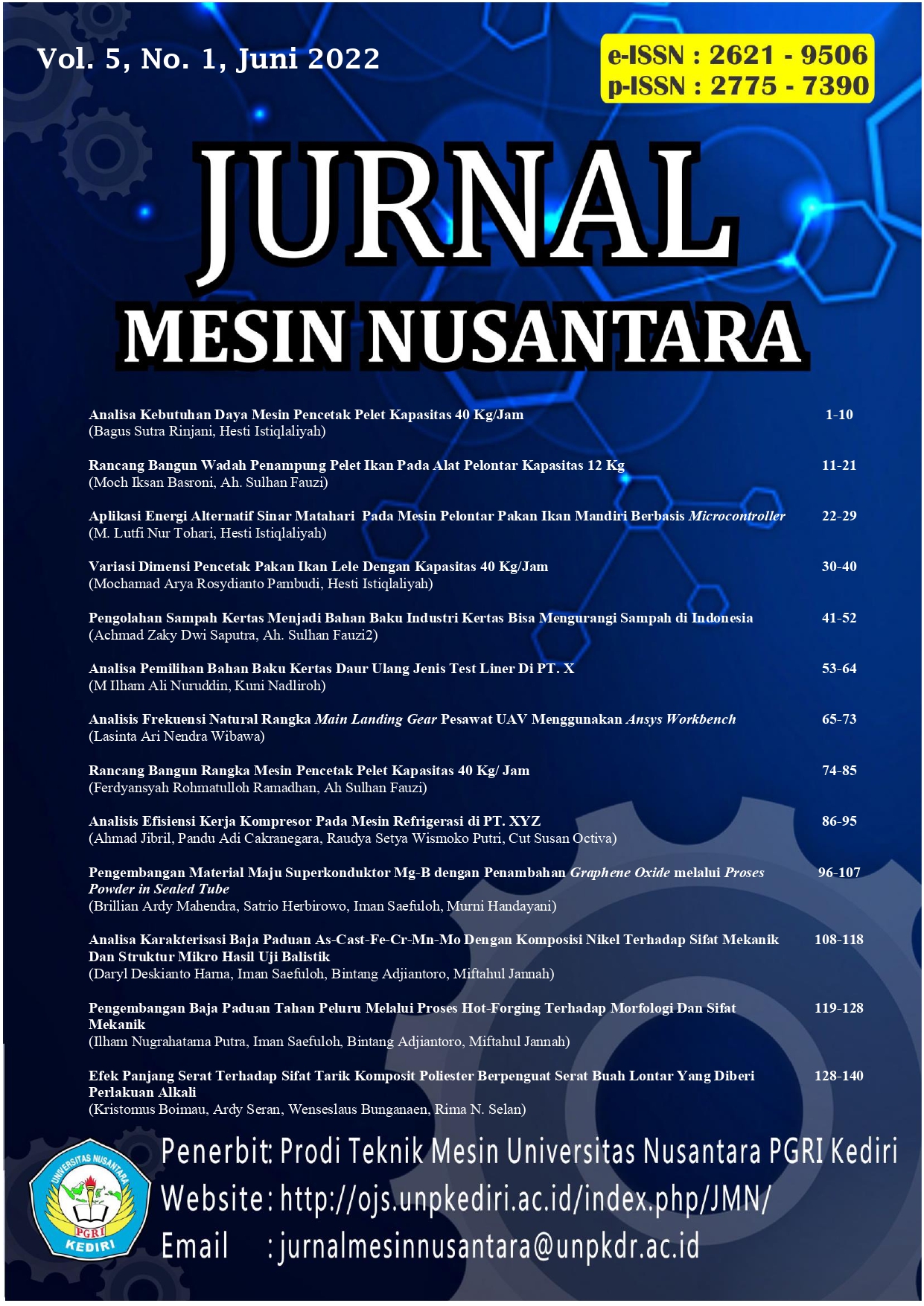Analisis Frekuensi Natural Rangka Main Landing Gear Pesawat UAV Menggunakan Ansys Workbench
DOI:
https://doi.org/10.29407/jmn.v5i1.17580Keywords:
modal analysis, ansys workbench, natural frequency, main landing gear UAV, finite element methodAbstract
The main landing gear is one of the important components in UAV aircraft. This paper aims to analyze the natural frequency of the main landing gear and determine its normal mode shape. This analysis is important so that no resonance causes damage to the main landing gear components. The main landing gear uses Aluminum 6061 material and the analysis is carried out using the finite element method with the help of Ansys Workbench software. The analysis showed that the natural main landing gear frequencies for mode 1 to mode 6 were 76.04 Hz, 85.07 Hz, 167.82 Hz, 201.92 Hz, 288.39 Hz, and 327.00 Hz, respectively. The maximum deformation of the main landing gear for mode 1 to mode 6 is 33.73 mm, 35.35 mm, 48.16 mm, 44.62 mm, 38.14 mm, and 41.51 mm, respectively.
Downloads
References
L. A. N. Wibawa, “Pengaruh Pemilihan Material Terhadap Kekuatan Rangka Main Landing Gear Untuk Pesawat UAV,” J. Technol. Implement. Bussines, vol. 2, no. 1, pp. 48–52, 2019.
L. A. N. Wibawa, “Pengaruh Kecepatan Landing Vertikal Terhadap Ketahanan Beban Impak Rangka Landing Gear Menggunakan Metode Elemen Hingga,” Angkasa J. Ilm. Bid. Teknol., vol. 11, no. 1, pp. 35–42, 2019.
L. A. N. Wibawa, “Pengaruh Diameter Baut Terhadap Kekuatan Rangka Main Landing Gear Pesawat UAV Menggunakan Metode Elemen Hingga,” J. Polimesin, vol. 17, no. 1, pp. 26–32, 2019.
L. A. N. Wibawa, “Pengaruh Susunan dan Jumlah Lubang Baut Terhadap Kekuatan Rangka Main Landing Gear Untuk Pesawat UAV,” Flywheel J. Tek. Mesin Untirta, vol. 5, no. 1, pp. 46–50, 2019.
L. A. N. Wibawa, “Simulasi Umur Fatik Rangka Main Landing Gear Menggunakan Metode Elemen Hingga,” Din. Tek. Mesin, vol. 10, no. 2, pp. 120–126, 2020.
Q. M. Fan, “Modal analysis of a truck transmission based on ANSYS,” Proc. - 4th Int. Conf. Inf. Comput. ICIC 2011, pp. 358–360, 2011.
F. Klimenda and J. Soukup, “Modal Analysis of Thin Aluminium Plate,” Procedia Eng., vol. 177, pp. 11–16, 2017.
M. A. B. Marzuki, M. H. A. Halim, and A. R. N. Mohamed, “Determination of natural frequencies through modal and harmonic analysis of space frame race car chassis based on ANSYS,” Am. J. Eng. Appl. Sci., vol. 8, no. 4, pp. 538–548, 2015.
A. Israr, “Vibration and modal analysis of low earth orbit satellite,” Shock Vib., vol. 2014, 2014.
S. Balaguru, E. Natarajan, S. Ramesh, and B. Muthuvijayan, “Structural and modal analysis of scooter frame for design improvement,” Mater. Today Proc., vol. 16, pp. 1106–1116, 2019.
S. Sahu and B. B. Choudhury, Stress and Modal Analysis of Six-Axis Articulated Robot Using ANSYS, vol. 40. Springer Singapore, 2019.
R. Fernandes, S. El-Borgi, K. Ahmed, M. I. Friswell, and N. Jamia, “Static fracture and modal analysis simulation of a gas turbine compressor blade and bladed disk system,” Adv. Model. Simul. Eng. Sci., vol. 3, no. 1, 2016.
J. K. Sharma and S. K. Parashar, “Experimental modal analysis using laser vibrometer and finite element modeling of milling machine arbor,” SN Appl. Sci., vol. 1, no. 6, pp. 1–10, 2019.
S. K. Sharma, Jai Kumar; Parashar, “Experimental Investigation Using Laser Vibrometer and Finite Element Modeling for Modal Analysis of Camshaft,” in Engineering Vibration, Communication and Information Processing, Lecture Notes in Electrical Engineering 478, vol. 478, Springer Singapore, 2019, pp. 121–129.
P. P. Kumar, Ashwani Kumar; Mamgain, Deepak Prasad; Jaiswal, Himanshu; Patil, “Modal Analysis of Hand-Arm Vibration (Humerus Bone) for Biodynamic Response Using Varying Boundary Conditions Based on FEA,” in Intelligent Computing, Communication and Devices, Advances in Intelligent Systems and Computing, vol. 308, 2015, pp. 169–176.
S. S. B. Chinka, B. Adavi, and S. R. Putti, “Effect of Crack Location and Crack Depth on Natural Frequencies of Fixed Beam Using Experimental Modal Analysis,” Recent Adv. Mater. Sci. Lect. Notes Multidiscip. Ind. Eng., pp. 93–103, 2019.
J. B. Ooi, X. Wang, C. S. Tan, J. H. Ho, and Y. P. Lim, “Modal and stress analysis of gear train design in portal axle using finite element modeling and simulation,” J. Mech. Sci. Technol., vol. 26, no. 2, pp. 575–589, 2012.
C. Bhowmik and P. Chakraborti, “Analytical and Experimental Modal Analysis of Electrical Transmission Tower to Study the Dynamic Characteristics and Behaviors,” KSCE J. Civ. Eng., vol. 24, no. 3, pp. 931–942, 2020.
S. S. Harak, S. C. Sharma, and S. P. Harsha, “Modal analysis of prestressed draft pad of freight wagons using finite element method,” J. Mod. Transp., vol. 23, no. 1, pp. 43–49, 2015.
L. A. N. Wibawa, “Desain dan Analisis Tegangan Alat Pengangkat Roket Kapasitas 10 Ton Menggunakan Metode Elemen Hingga,” J. Energi dan Teknol. Manufaktur, vol. 02, no. 01, pp. 23–26, 2019.
L. A. N. Wibawa, “Desain dan Analisis Tegangan Crane Hook Model Circular Section Kapasitas 5 Ton Menggunakan Autodesk Inventor 2017,” Simetris J. Tek. Mesin, Elektro dan Ilmu Komput., vol. 10, no. 1, pp. 27–32, 2019.
Downloads
Published
Issue
Section
License
Authors who publish with this journal agree to the following terms:
- Copyright on any article is retained by the author(s).
- The author grants the journal, right of first publication with the work simultaneously licensed under a Creative Commons Attribution License that allows others to share the work with an acknowledgment of the work’s authorship and initial publication in this journal.
- Authors are able to enter into separate, additional contractual arrangements for the non-exclusive distribution of the journal’s published version of the work (e.g., post it to an institutional repository or publish it in a book), with an acknowledgment of its initial publication in this journal.
- Authors are permitted and encouraged to post their work online (e.g., in institutional repositories or on their website) prior to and during the submission process, as it can lead to productive exchanges, as well as earlier and greater citation of published work.
- The article and any associated published material is distributed under the Creative Commons Attribution-ShareAlike 4.0 International License












